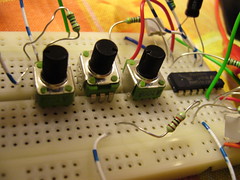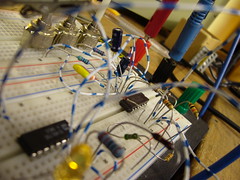Pushpin Gameboy MIDI synth now open source!
November 27th, 2007Have you ever heard about the Pushpin Gameboy MIDI synth? It’s a mysterious thing that I first saw maybe around 2000 or 2001. Over the years I’ve tried to reach the creators of this project, but without success. I thought the whole thing was fake, and that the music was perhaps made with LSDj or some other software.
As I know now, that’s not the case, but I wonder why it took them 7 years of silence before getting Pushpin out to the world.
This is an interesting piece of software that I have waited for for a long time now. I’ll build an interface as soon as I can. And I’m also going to try to do what I can to help the project, in terms of hardware and software development.
So far, I’ve written a Pushpin hardware tutorial, which I will update as time goes by.
The program and source code can be downloaded from the Pushpin Google Code page and there’s also documentation on variogr.am.
SID2SID with two different SID flavours: Finished
November 22nd, 2007I finally inished my special SID2SID, which has a little hack that allows you to use two different flavours of SID on the same board, at least if used on a 6581 board. The trick is to regulate the 12V used for the 6581 down to 9V, for the 8580. The 8580 should use the same filter caps as 8580 always uses. I don’t remember the value, but the SID2SID manual covers this.
Here’s my test setup:
Prophet64 still identifies the main SID, a 6581. On the right, the audio outpus from the SIDs.


And here is a closer look of the little beauty. It’s too much of a snake’s nest, but that was because of a mistake of mine. The left picture is the bottom side of the SID2SID. It’s filled with dirty tricks. The first thing I want to point out is the voltage regulator. It has three wires. For the voltage regulator to have any effect at all, you have to cut the trace to VDD and connect the voltage regulator. (If you don’t know, or can’t find instructions, how to connect a voltage regulator, you probably shouldn’t do this mod, so I won’t tell you the exact wiring.)
I first cut the wrong trace, so there’s one excess wire to fix that.
The regulator should be a 7809, (+9 V regulator) but all I could find was a 7808. (+8 V regulator) That’s 1 V too low, but works, and will hopefully help keep the chip cool. The big cap attached to it was an attempt to keep noise in VDD to a minimum, but didn’t help much. However, it fits perfectly between the IC sockets and keeps the regulator steady in one place.
The resistor on the upper left grounds the SID sound input, which reduces the noise a little. The resistor on the lower left charges DC blocking cap, so that it’s nicely charged when you plug it into something. Hopefully this will help protect the chip, but maybe it will make it burn out faster. Time will tell.
No sounds samples up yet sorry, but it works fine. What doesn’t work fine is joystick port 2, where the fire button seems to be fried from ESD. (I finally realized this) So unless I learn how to use P64 without a mouse, no fun for some time. (But I can still use drummer and bassline of course.)
In the long run, I’d like to implement one or more of AlphA’s C64 mods. I will also try to modify the filter circuit in a strange way, bend if you will. Any news, and you’ll hear it here.
Also, fuckings to ps.
Update: Answer to Joey’s question:
In order to do what you want to you have drop the voltage and replace the caps, yes. The easiest way to replace the caps for SID 1 is to cut the 4 filter legs of the board, and solder 8580 compatible capacitors on the SID2SID board. The SID2SID cover this topic well.
As for regulating the voltage, I advise you to cut off the VDD pin, or possible bend it upwards in some acrobatic manner. That’s where the higher voltage goes onto the SID2SID board, somehow making sure that pin is not directly connect to the 12 V source on the board is crucial if you don’t want to fry two chips in one go. (*Shudders*)
Then you can connect the output of the regulator to that pin you’ve just bent/cut. Ground goes to ground and input goes to input. Crazy as I am, in your situation I would’ve tried to somehow fit the regulator where the VDD pin was. This way you can just put down the chip in the socket and the regulator leg would go in the right place. But that’s overkill, really.
Just make sure the VDD is regulated. And make sure the 12 V you have found is source is actually connected to the power supply. (Put your multimeter in diode mode, and probe the point you’ve found and pin 28 on the SID socket, while the machine is off)
If you need it, here is the SID pinout and the SID2SID manual.
Good luck!
Edit: The lurvtrut was removed in favour for an actual SID pinout.
The Moxibustor - A glitchy oscillator
September 15th, 2007

Here we have the second prototype of the Moxibustor glitch oscillator synth. The first prototype had slightly different components, and reminded me of a dub siren in some modes. The second prototype has slightly different components and also a second IC.
What does the Moxibustor do really? It has three knobs and a buttons. Each knob controls the frequency of an astable Schmitt trigger oscillator. The frequency ranges have are different on purpose, so one of the oscillators can go down to down to sub-bass frequencies, and work as an LFO, and one can go up to 1 kHz or so.
The three signals are mixed digitally at the resolution of 1 bit. This clips the three square waves even more, which gives an effect called intermodulation distorsion, which slightly, but not completely, resembles ring modulation. Then there’s also a secondary chip, a decade counter (Just happened to have it lying around :p )
The result is a glitchy thing that offers a variety of glitchy square wave-ish sounds.
But don’t take my word for it, listen for yourself. (Caution: loud)
http://www.gg8.se/music/moxibustor.mp3
If you’re interested in buying a special made piece of this machine, please contact me.
![You suck at protoshop. No, you [i]really[/i] oo.](http://blog.gg8.se/images/you-suck-at-photoshop-you-really-do-your-awful.png)






